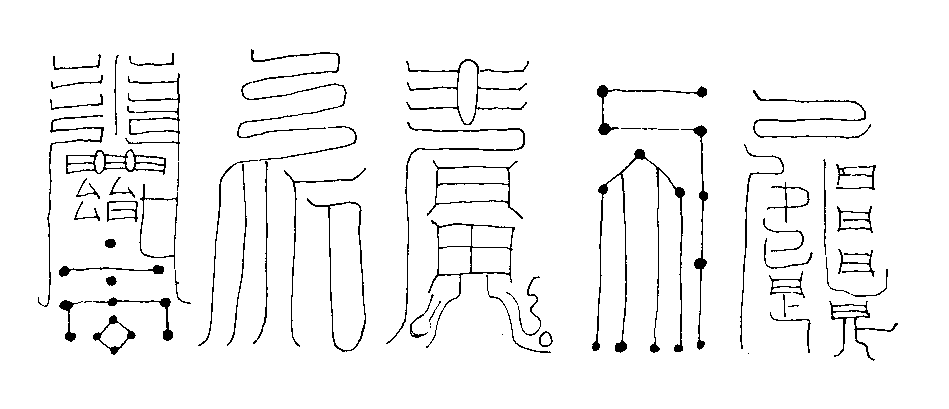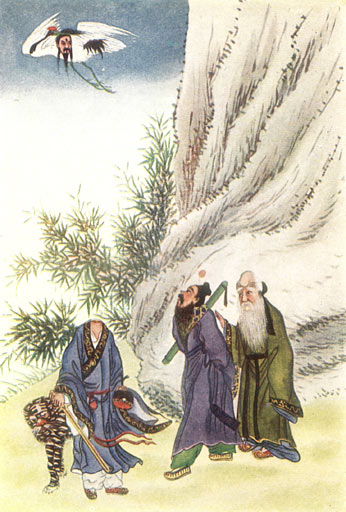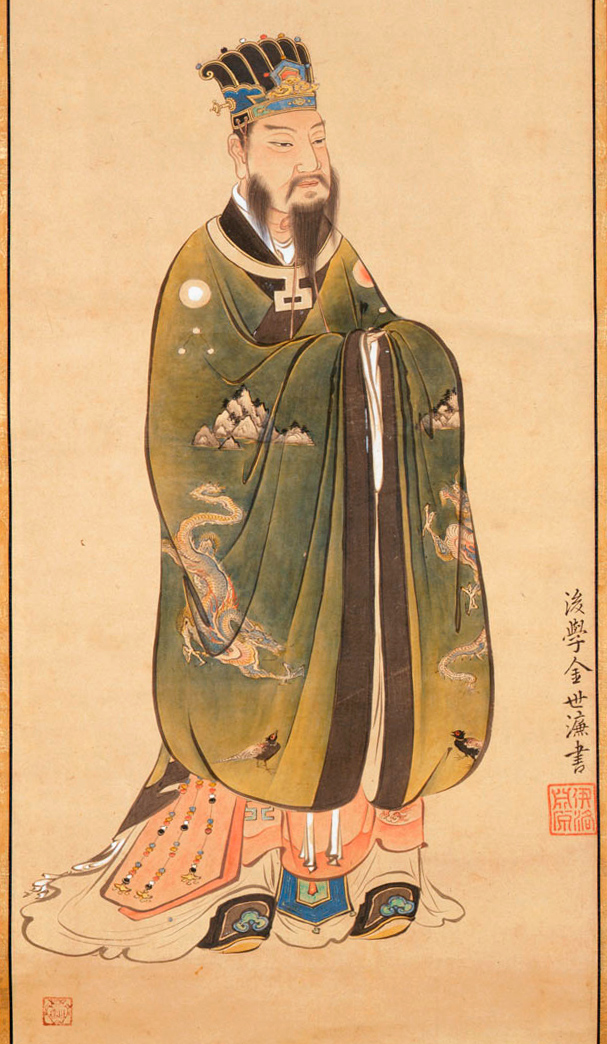|
Fox Spirit
Huli jing () are Chinese mythological creatures usually capable of shapeshifting, who may either be benevolent or malevolent spirits. In Chinese mythology and folklore, the fox spirit takes variant forms with different meanings, powers, characteristics, and shapes, including ''huxian'' (), ''hushen'' (), ''husheng'' (), ''huwang'' (), ''huyao'' (), and ''jiuweihu'' (). Fox spirits and nine-tailed foxes appear frequently in Chinese folklore, literature, and mythology. Depending on the story, the fox spirit's presence may be a good or a bad omen. The motif of nine-tailed foxes from Chinese culture was eventually transmitted and introduced to Japanese and Korean cultures. Descriptions The nine-tailed fox occurs in the ''Shanhaijing'' (''Classic of Mountains and Seas''), compiled from the Warring States period to the Western Han period (circa fourth to circa first century BC). The work states: In chapter 14 of the ''Shanhaijing'', Guo Pu, a scholar of the Eastern Jin dynasty, ... [...More Info...] [...Related Items...] OR: [Wikipedia] [Google] [Baidu] |
Chinese Mythology
Chinese mythology () is mythology that has been passed down in oral form or recorded in literature in the geographic area now known as Greater China. Chinese mythology includes many varied myths from regional and cultural traditions. Much of the mythology involves exciting stories full of fantastic people and beings, the use of magical powers, often taking place in an exotic mythological place or time. Like many mythologies, Chinese mythology has in the past been believed to be, at least in part, a factual recording of history. Along with Chinese folklore, Chinese mythology forms an important part of Chinese folk religion. Many stories regarding characters and events of the distant past have a double tradition: ones which present a more historicized or euhemerized version and ones which present a more mythological version. Many myths involve the creation and cosmology of the universe and its deities and inhabitants. Some mythology involves creation myths, the origin of things, ... [...More Info...] [...Related Items...] OR: [Wikipedia] [Google] [Baidu] |
Baopuzi
The ''Baopuzi'' () is a literary work written by Ge Hong (also transliterated as Ko Hung) (), 283–343, a scholar during the turbulent Jin dynasty. ''Baopuzi'' is divided into two main sections, the esoteric ''Neipian'' () "Inner Chapters" and equally exoteric ''Waipian'' () "Outer Chapters". The Taoist Inner Chapters discuss topics such as techniques to achieve "hsien" () "immortality; transcendence", Chinese alchemy, elixirs, and demonology. The Confucian Outer Chapters discuss Chinese literature, Legalism, politics, and society. Title The eponymous title ''Baopuzi'' derives from Ge Hong's ''hao'' (), the ''hao'' being a type of sobriquet or pseudonym. Baopuzi literally means "The Master Who Embraces Simplicity;" compounded from the words ''bao'' () meaning "embrace; hug; carry; hold in both arms; cherish"; '' pu'' () meaning "uncarved wood", also being a Taoist metaphor for a "person's original nature; simple; plain"; and, ''zi'' ( 子) meaning "child; offspring; maste ... [...More Info...] [...Related Items...] OR: [Wikipedia] [Google] [Baidu] |
Jiang Ziya
Jiang Ziya ( century BC – century BC), also known by several other names, was a Chinese noble who helped kings Wen and Wu of Zhou overthrow the Shang in ancient China. Following their victory at Muye, he continued to serve as a Zhou minister. He remained loyal to the regent Duke of Zhou during the Rebellion of the Three Guards; following the Duke's punitive raids against the restive Eastern Barbarians or ''Dongyi'', Jiang was enfeoffed with their territory as the marchland of Qi. He established his seat at Yingqiu (in modern Linzi). Names The first marquis of Qi bore the given name Shang. The nobility of ancient China bore two surnames, an ancestral name and a clan name. His were Jiang (姜) and Lü (呂), respectively. He had two courtesy names, Shangfu (尚父; lit. "Esteemed Father") and Ziya (lit. "Master Ivory, Master Tusk"), which were used for respectful address by his peers. The names Jiang Shang and Jiang Ziya became the most common after th ... [...More Info...] [...Related Items...] OR: [Wikipedia] [Google] [Baidu] |
King Wen Of Zhou
King Wen of Zhou (; 1152–1050 BC, the Cultured King) was Count of state of Zhou, Zhou during the late Shang dynasty in ancient China. Although frequently confused with his fourth son Duke of Zhou, also known as "Lord Zhou", they are different historical persons. Although it was his son King Wu of Zhou, Wu who conquered the Shang following the Battle of Muye, Count Wen was posthumously honored as the founder of the Zhou dynasty and posthumously titled King. Many of the hymns of the ''Classic of Poetry'' are praises to the legacy of King Wen. Some consider him the first epic hero of Chinese history. Archaeology Chinese scholars (e.g. Wang Yunwu (:zh:王雲五, 王雲五), Li Xueqin (:zh:李学勤, 李学勤), etc.) identified King Wen with a mentioned in inscriptions H11:82 & H11:84 among oracle bones excavated at Zhouyuan (), Qishan County. Biography Born Ji Chang (), Wen was the son of Tai Ren, Tairen and King Ji of Zhou, Ji Jili, the Count of Predynastic Zhou, Zhou, a vassal ... [...More Info...] [...Related Items...] OR: [Wikipedia] [Google] [Baidu] |
Shang Dynasty
The Shang dynasty (), also known as the Yin dynasty (), was a Chinese royal dynasty founded by Tang of Shang (Cheng Tang) that ruled in the Yellow River valley in the second millennium BC, traditionally succeeding the Xia dynasty and followed by the Western Zhou dynasty. The classic account of the Shang comes from texts such as the '' Book of Documents'', '' Bamboo Annals'' and '' Records of the Grand Historian''. According to the traditional chronology based on calculations made approximately 2,000 years ago by Liu Xin, the Shang ruled from 1766 to 1122 BC, but according to the chronology based upon the "current text" of ''Bamboo Annals'', they ruled from 1556 to 1046 BC. Comparing the same text with dates of five-planet conjunctions, David Pankenier, supported by David Nivison, proposed dates of the establishment of the dynasty to 1554 BC. The Xia–Shang–Zhou Chronology Project dated the establishment to c. 1600 BC based on the carbon-14 dates of th ... [...More Info...] [...Related Items...] OR: [Wikipedia] [Google] [Baidu] |
Nüwa
Nüwa, also read Nügua, is the mother goddess of Chinese mythology. She is credited with creating humanity and repairing the Pillar of Heaven. As creator of mankind, she molded humans individually by hand with yellow clay. In the Huainanzi, there is described a great battle between deities that broke the pillars supporting Heaven and caused great devastation. There was great flooding, and Heaven had collapsed. Nüwa was the one who patched the holes in Heaven with five colored stones, and she used the legs of a tortoise to mend the pillars. There are many instances of her in literature across China which detail her in creation stories, and today remains a figure important to Chinese culture. Name The character ''nü'' ( zh, t=女, l=female) is a common prefix on the names of goddesses. The proper name is ''wa'', also read as ''gua'' ( zh, t=媧). The Chinese character is unique to this name. Birrell translates it as 'lovely', but notes that it "could be construed as 'fr ... [...More Info...] [...Related Items...] OR: [Wikipedia] [Google] [Baidu] |
King Zhou Of Shang
King Zhou (; ) was the pejorative posthumous name given to Di Xin of Shang () or King Shou of Shang (), the last king of the Shang dynasty of ancient China. He is also called Zhou Xin (). In Chinese, his name Zhòu (wikt:紂, 紂) also refers to a horse crupper, the part of a saddle or harness that is most likely to be soiled by the horse. It is not to be confused with the name of the Zhou dynasty, succeeding dynasty which has a different character and pronunciation (). Early reign In the ''Records of the Grand Historian'', Sima Qian wrote that Di Xin, in the early part of his reign, had abilities which surpassed those of the ordinary man, and was quick-witted and quick-tempered. According to legend, he was intelligent enough to win all of his arguments, and he was strong enough to hunt wild beasts with his bare hands. He was the younger brother of Weizi of Song, Zi Qi (子啓) and Weizhong of Song, Zi Yan (子衍) (later rulers of Zhou dynasty, Zhou's vassal state Song (state), So ... [...More Info...] [...Related Items...] OR: [Wikipedia] [Google] [Baidu] |
Fengshen Yanyi
''The Investiture of the Gods'', also known by its Chinese names () and is a 16th-century Chinese novel and one of the major vernacular Chinese works in the gods and demons (''shenmo'') genre written during the Ming dynasty (1368–1644). Consisting of 100 chapters, it was first published in book form between 1567 and 1619. Another source claims it was published in 1605. The work combines elements of history, folklore, mythology, legends and fantasy.Chew, Katherine Liang (2002). ''Tales of the Teahouse Retold: Investiture of the Gods''. Page XI. . The story is set in the era of the decline of the Shang dynasty (1600–1046 BC) and the rise of the Zhou dynasty (1046–256 BC). It intertwines numerous elements of Chinese mythology, including deities, immortals and spirits. The authorship is attributed to Xu Zhonglin. Plot The novel is a romanticised retelling of the overthrow of King Zhou, the last ruler of the Shang dynasty, by Ji Fa, who would establish the Zhou ... [...More Info...] [...Related Items...] OR: [Wikipedia] [Google] [Baidu] |
Shenmo
Gods and demons fiction () is a subgenre of fantasy fiction that revolves around the deities, immortals, and monsters of Chinese mythology. The term ''shenmo xiaoshuo'', coined in the early 20th century by the writer and literary historian Lu Xun, literally means "fiction of gods and demons". Works of shenmo fiction include the novels ''Journey to the West'' and ''Investiture of the Gods''. History ''Shenmo'' first appeared in the Ming Dynasty as a genre of vernacular fiction, a style of writing based on spoken Chinese rather than Classical Chinese. The roots of the genre are found in traditional folktales and legends. Plot elements like the use of magic and alchemy were derived from Chinese mythology and religion, including Taoism and Buddhism, popular among Ming intellectuals. ''The Three Sui Quash the Demons' Revolt'' (, 14th century CE) is an early gods and demons novel attributed to Luo Guanzhong. In the story, Wang Ze begins a rebellion against the government with th ... [...More Info...] [...Related Items...] OR: [Wikipedia] [Google] [Baidu] |
Ming Dynasty
The Ming dynasty (), officially the Great Ming, was an Dynasties in Chinese history, imperial dynasty of China, ruling from 1368 to 1644 following the collapse of the Mongol Empire, Mongol-led Yuan dynasty. The Ming dynasty was the last orthodox dynasty of China ruled by the Han Chinese, Han people, the majority ethnic group in China. Although the primary capital of Beijing fell in 1644 to a rebellion led by Li Zicheng (who established the short-lived Shun dynasty), numerous rump state, rump regimes ruled by remnants of the House of Zhu, Ming imperial family—collectively called the Southern Ming—survived until 1662. The Ming dynasty's founder, the Hongwu Emperor (r. 1368–1398), attempted to create a society of self-sufficient rural communities ordered in a rigid, immobile system that would guarantee and support a permanent class of soldiers for his dynasty: the empire's standing army exceeded one million troops and the naval history of China, navy's dockyards in Nanjin ... [...More Info...] [...Related Items...] OR: [Wikipedia] [Google] [Baidu] |
Daji
Daji () was the favourite consort of King Zhou of Shang, the last king of the Shang dynasty in History of China, ancient China. In legends and fictions, she is portrayed as a malevolent fox spirit who kills and impersonates the real Daji. Her identification as a fox spirit seems to have originated from at least the Tang dynasty. These accounts have been popularized in works such as the (), the , and the . She is considered a classic example of how a beautiful femme fatale can cause the downfall of a dynasty in Chinese culture. In the Song dynasty, fox spirit cults, including those dedicated to Daji, became outlawed, but their suppression was unsuccessful. For example, in 1111, an imperial edict was issued for the destruction of many spirit shrines within Kaifeng, including those of Daji. Biography Daji was from a noble family of Yousu (); her style name is Da (), and her clan name is Ji (). Hence, she is also known as Su Da Ji or Da Ji in ancient sources. At some time during hi ... [...More Info...] [...Related Items...] OR: [Wikipedia] [Google] [Baidu] |
Youyang Zazu
The ''Miscellaneous Morsels from Youyang'' () is a book written by Duan Chengshi in the 9th century. It focuses on miscellany of Chinese and foreign legends and hearsay, reports on natural phenomena, short anecdotes, and tales of the wondrous and mundane, as well as notes on such topics as medicinal herbs and tattoos. ''Youyang'' refers to the south slope of ''Mount You'', a small hill located in what is now Huaihua, Hunan. The book is divided into 30 volumes, containing unusually varied content in over thirteen hundred entries that describe the world that Duan Chengshi heard about, read of, or personally observed. Several tales from the volume are quoted in the Taiping Guangji. The ''Ye Xian'', a story similar to the fairy tale ''Cinderella'', appears in Chapter 21. The story was allegedly told by Duan's servant Li Shiyuan, a native from what is now Nanning. It is set during the late 3rd century BC. The exact location is unknown, but the most likely candidate is Guangxi ... [...More Info...] [...Related Items...] OR: [Wikipedia] [Google] [Baidu] |






.jpg)